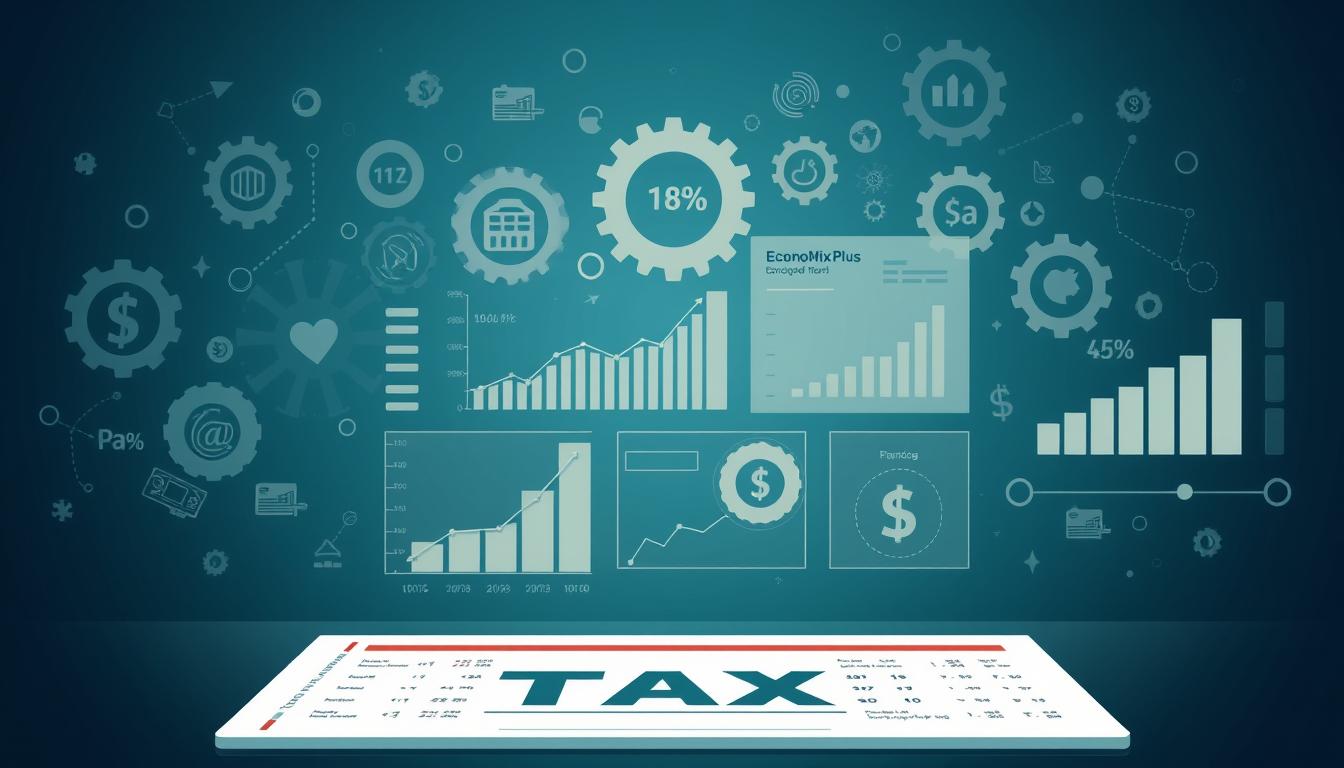Can a nation’s approach to taxation truly bridge the gap between wealth and equality? Governments rely on tax systems to fund essential services like education and healthcare. But how these frameworks are designed can either widen or narrow economic divides. In developed nations, balancing revenue generation with fairness remains a critical challenge.
Modern income tax structures often prioritize progressive models, where higher earners contribute a larger share. This method aims to redistribute resources while maintaining incentives for growth. Corporate tax rates also play a role, influencing business investments and job creation. When designed thoughtfully, these policies minimize economic distortions and encourage compliance.
Countries like the U.S. and Germany use layered approaches to address inequality. Their codes include deductions for low-income households and credits for social programs. Such measures ensure that economic development benefits all citizens, not just the wealthy. The effectiveness of these systems depends on transparency and adaptability to changing needs.
Key Takeaways
- Progressive income tax models aim to reduce wealth gaps by taxing higher earners at elevated rates.
- Corporate tax policies influence business behavior and job markets, impacting overall fairness.
- Simplified tax codes improve compliance and reduce loopholes that benefit the wealthy.
- Deductions and credits for low-income households help balance economic opportunities.
- No traditional savings products like bonds or fixed-income tools are discussed here.
Introduction to Modern Tax Systems in Developed Countries
Balancing revenue and equity requires modern nations to rethink how they collect and allocate resources. Over 70% of OECD members now combine income taxes with consumption-based levies like VAT. This layered approach diversifies funding sources while limiting over-reliance on any single group.

Broadening the tax base has become central to recent reforms. By including more taxpayers through VAT and payroll deductions, governments lower top rates without sacrificing revenue. For example, Germany’s VAT generates 19% of total tax income, reducing pressure on high earners alone.
Payroll taxes also play a critical role. In the U.S., they fund Social Security and Medicare – programs directly benefiting middle-class households. These mechanisms create stability, ensuring essential services aren’t jeopardized by market fluctuations.
OECD data shows consumption taxes now average 20.2% across member states, up from 18% in 2000. This shift reflects efforts to balance efficiency with progressive principles. As tax systems evolve, their success increasingly hinges on transparency and public trust in how funds are used.
Understanding Economic Fairness Through Tax Policy
Economic fairness hinges on designing tax structures that balance equity and efficiency. Developed nations achieve this by aligning tax compliance with social priorities, ensuring resources flow to critical services like healthcare and infrastructure.
Defining Economic Fairness
A fair system requires those with greater means to contribute proportionally more. Neutral tax codes – those avoiding favoritism – generate tax revenue without distorting business decisions. OECD studies show broad-based taxes (like VAT) reduce evasion while funding universal programs.

Impact on Public Services and Growth
When countries tax efficiently, they reinvest in education and transportation. For example:
| Country | Tax Strategy | Outcome |
|---|---|---|
| Norway | High VAT + Wealth Tax | 98% literacy rate |
| Canada | Progressive Income Tax | 70% public healthcare coverage |
| Germany | Payroll Deductions | 4.2% GDP growth (2023) |
This approach boosts tax compliance by demonstrating tangible benefits. The OECD reports nations with transparent systems see 15% higher revenue collection. Such funds enable investments that spur long-term economic expansion.
Balanced policies also prevent overburdening any single group. By combining income, corporate, and consumption levies, governments maintain stable tax revenue streams even during recessions. This stability allows continuous improvements in public services that drive shared prosperity.
Global Trends in Corporate Tax Reforms
Corporate taxation strategies are undergoing rapid transformation as nations adapt to shifting economic realities. Over 30 developed countries revised their corporate tax codes since 2020, balancing revenue needs with global competition. This wave of changes reflects both domestic priorities and international coordination efforts.

Recent Reforms and Data Insights
The United States cut its federal corporate rate from 35% to 21% in 2018, while France reduced theirs to 25% by 2022. Conversely, Japan implemented a rates increase for large enterprises, reaching 30.62% in 2023. OECD reports show 40% of member states now use digital services taxes targeting tech giants.
Comparative Corporate Tax Rates
| Country | 2020 Rate | 2023 Rate | Policy Focus |
|---|---|---|---|
| United States | 21% | 21% | Domestic investment |
| Germany | 29.9% | 29.9% | Manufacturing support |
| France | 31% | 25% | Startup incentives |
| Japan | 29.74% | 30.62% | Debt reduction |
Three key patterns emerge from recent adjustments:
- Marginal rate reductions in 60% of developed countries
- Expanded tax bases through stricter deduction rules
- New levies targeting intangible assets and data-driven profits
These reforms aim to attract multinational headquarters while funding infrastructure projects. However, countries may face challenges enforcing cross-border tax rules. The 2023 Global Tax Competitiveness Index notes improved compliance in nations adopting real-time reporting systems.
Balancing act continues as rates increase for specific sectors while overall corporate burdens decline. Successful implementation requires addressing profit-shifting tactics through agreements like the G7’s 15% global minimum tax framework.
Evolution of Income and Consumption Taxes
Tax structures in advanced economies have transformed over decades, blending simplicity with equitable revenue collection. Governments now prioritize systems that reduce administrative burdens while maintaining fairness. This shift reflects lessons from past complexities and the need for adaptable frameworks.

Shifts in Individual Income Tax Strategies
In the 1980s, many nations used multi-bracket income taxes with extensive deductions. By 2023, 18 OECD members adopted flat or semi-flat structures. Sweden’s 30% flat rate for incomes above $58,000 streamlined tax administration, cutting processing time by 40%. The U.S. simplified its code in 2017, doubling the standard deduction to $12,950 – a move that increased compliance by 12% among middle-income filers.
The Role of VAT and Payroll Taxes
Value-added taxes now fund 20% of public budgets in the EU, up from 15% in 2000. Germany’s 19% VAT rate supports universal healthcare, while France uses payroll levies to finance unemployment benefits. These consumption-based tools balance revenue streams without overburdening high earners.
Simplified systems demonstrate three advantages:
- Reduced processing costs for tax administration
- Higher voluntary reporting rates through increased compliance
- Stable funding for social safety nets
The political economy of reform often determines success. When Canada merged provincial/federal sales taxes into harmonized VAT, public acceptance grew as citizens saw clearer service links. Such changes prove that efficient structures can align fiscal needs with societal expectations.
Assessing the Tax Base and Compliance Challenges
Expanding revenue sources while maintaining fairness requires precise calibration of tax bases. A broad framework minimizes loopholes and spreads contributions across more payers. OECD research shows nations with comprehensive bases collect 22% more revenue at 5% lower average rates compared to narrow systems.
Broadening the Tax Base
Including diverse income streams – from gig work to capital gains – strengthens fiscal stability. Sweden’s 2022 reforms added digital service providers to its VAT net, boosting annual revenues by $1.3 billion. Wider coverage reduces pressure to hike rates, as seen in Canada’s 14% corporate tax stability despite economic shifts.
| Country | Tax Base Breadth | Compliance Rate | Revenue Impact |
|---|---|---|---|
| Sweden | 85% of GDP | 93% | +4.1% (2023) |
| Canada | 78% of GDP | 89% | +2.7% |
| Italy | 62% of GDP | 74% | -1.2% |
Improving Tax Compliance Efficiency
Real-time reporting systems cut enforcement costs by 30% in early-adopter nations like Estonia. Automated audits and stricter penalties reduced evasion by 18% in Germany since 2020. However, 37% of OECD members still struggle with outdated tracking methods.
Digital integration proves critical. The U.S. saw voluntary filings rise 9% after implementing AI-driven error detection. As one IRS official noted: “Modern tools make compliance simpler than evasion.” These advancements help governments redirect savings into growth-focused initiatives.
Insights from the International Tax Competitiveness Index
Global tax frameworks face intense scrutiny as nations compete for investment while maintaining public trust. The International Tax Competitiveness Index evaluates how well advanced economies balance efficiency with fairness. This annual ranking assesses 38 OECD members using five criteria: corporate rates, individual burdens, consumption taxes, property levies, and cross-border rules.
Methodology and Key Indicators
The index prioritizes neutrality – measuring how tax codes influence business decisions. High scores go to nations with broad bases and low marginal rates. Estonia’s top-ranked system combines a 20% corporate rate with territorial taxation, exempting foreign profits. This approach minimizes distortions while funding universal digital services.
Country Comparisons and Rankings
2023 data reveals striking contrasts:
| Country | Corporate Rate | Individual Top Rate | Overall Rank |
|---|---|---|---|
| Estonia | 20% | 20% | 1 |
| Switzerland | 14.6% | 41.7% | 4 |
| United States | 25.8% | 37% | 28 |
Switzerland’s 14.6% average corporate rate attracts multinational headquarters without sacrificing revenue. Meanwhile, France’s 55% individual burden contributes to its 34th-place finish. The index shows efficient systems often feature:
- Transparent reporting requirements
- Limited double taxation
- Stable policy environments
These rankings challenge the notion that high taxes ensure fairness. Estonia’s model proves competitive rates paired with smart administration can fund robust social programs. As countries modernize their codes, this benchmark highlights paths to economic vitality without compromising equity.
Temporary Tax Changes and Policy Adjustments Post-COVID
As economies reeled from lockdowns, temporary tax measures became crucial lifelines. Over 80% of OECD members introduced emergency fiscal policies between 2020-2022. These adjustments aimed to stabilize businesses while protecting vulnerable households during unprecedented disruptions.
- Deferred payment deadlines for corporate levies in 23 countries
- Temporary rate reductions for hospitality sectors
- Enhanced deductions for pandemic-related expenses
Germany slashed VAT from 19% to 16% for six months in 2020, injecting €20 billion into consumer spending. The UK cut hospitality VAT to 5% for nine months, saving restaurants an average of £18,000 each. Such targeted relief preserved 4.7 million jobs across Europe according to EU Commission data.
While these moves provided immediate liquidity, some created future challenges. Canada’s deferred tax program left a C$38 billion revenue gap by 2023. OECD analysis shows 60% of temporary rates were extended beyond original timelines, risking structural deficits.
The balance between crisis response and fiscal sustainability remains delicate. As one Treasury official noted: “Emergency measures must expire before becoming permanent crutches.” Successful policies like Australia’s instant asset write-offs – which boosted equipment purchases by 31% – demonstrate how time-bound gains can spark recovery without compromising long-term fairness.
Comparative Analysis: Developed versus Developing Countries
How do fiscal frameworks in affluent and emerging economies diverge in addressing societal needs? Advanced nations typically rely on broad-based VAT systems with high compliance, while developing regions often struggle with fragmented consumption taxes. These structural differences shape economic outcomes and equity.
Differences in Tax Structuring
Developed economies apply VAT uniformly across most goods and services, averaging 20% rates. Exemptions target essentials like food and medicine. Conversely, 63% of developing nations use multi-tiered consumption taxes, creating administrative complexity. Nigeria’s 7.5% standard rate coexists with 5% levies on telecoms, leading to frequent disputes.
| Country Group | Avg VAT Rate | Compliance Rate | Revenue Share |
|---|---|---|---|
| Developed | 19.8% | 89% | 32% of total |
| Developing | 13.4% | 54% | 18% of total |
Digital infrastructure gaps explain part of this divide. Norway processes 97% of VAT filings electronically, while Ghana relies on manual audits for 40% of collections. Such disparities limit developing nations’ ability to fund healthcare and education equitably.
Informal economies further strain systems in emerging markets. India’s 2023 reforms expanded GST coverage to e-commerce, yet 28% of small businesses remain unregistered. Addressing these challenges requires balancing simplicity with targeted enforcement – a lesson affluent nations mastered decades ago.
Enhancing Tax Administration and Enforcement
Modern technology reshapes how governments collect funds while maintaining public trust. Efficient taxation processes cut bureaucratic costs and boost voluntary compliance. Estonia’s fully digital system processes returns in under 15 minutes, saving $3 million annually in administrative expenses.
Broadening the base requires smarter enforcement tools. Chile’s risk-based auditing system increased collections by 19% without raising rates. “Digital tracking makes evasion harder than compliance,” notes their Tax Director. Real-time data analysis now identifies discrepancies 40% faster than manual reviews.
| Country | Strategy | Outcome |
|---|---|---|
| Estonia | AI-driven audits | 98% compliance rate |
| Chile | Risk-based targeting | +$2.1B revenue |
| Ireland | Pre-filled tax forms | 87% filing accuracy |
Automation proves critical for revenue growth. Ireland’s pre-filled income statements reduced errors by 63% since 2021. These approaches demonstrate that streamlined administration supports both equity and efficiency.
Investments in staff training yield high returns. Canada’s specialized fraud units recovered $4.8 billion in 2023 alone. When citizens see fair enforcement, voluntary participation rises – closing gaps in the base without legislative changes.
Effective taxation relies on balancing tech solutions with human oversight. As Chile’s success shows, smarter systems fund public services while reinforcing trust in economic structures.
Debating Flat Tax Systems in Developed Economies
Flat tax proposals spark heated debates among economists and policymakers. Advocates argue single-rate structures boost investment by simplifying decisions, while critics warn they may widen wealth gaps. Recent studies show these systems generate mixed outcomes depending on implementation.
Incentives for Investment and Growth
Estonia’s 20% flat rate on corporate profits attracted 43% more foreign direct investment since 2020. Uniform rates eliminate complex calculations, letting businesses focus on expansion. A 2023 IMF study found flat tax adopters saw 2.1% higher annual GDP growth than peers.
| Country | Flat Tax Rate | GDP Growth | Compliance Rate |
|---|---|---|---|
| Estonia | 20% | 3.4% | 94% |
| Latvia | 20% | 2.8% | 89% |
| Lithuania | 15% | 1.9% | 82% |
Simplicity Versus Redistribution Challenges
Single-rate systems reduce compliance costs by 30-40% according to OECD data. However, Tax Policy Center simulations show middle-income households could lose $4,700 annually under U.S. flat tax proposals. “Simplicity gains might outweigh fairness concerns in fast-growing economies,” notes Harvard economist Jason Furman.
Balancing growth incentives with equity remains contentious. While Baltic nations use supplemental benefits to protect low earners, critics argue this recreates complexity. Recent German modeling suggests hybrid models – flat rates above income thresholds – may offer compromise solutions.
Political Economy in Tax Policy Reforms
Tax policy changes rarely emerge from purely economic logic. Power dynamics between elected officials, corporations, and advocacy groups often steer reforms toward compromised outcomes. A recent simulation study found lobbying efforts alter 37% of proposed tax legislation in advanced economies. These pressures create efficiency trade-offs, where ideal policy designs clash with political realities.
Influence of Stakeholders and Lobbying
Industry groups spent $2.9 billion on U.S. tax lobbying between 2017-2022, securing $428 billion in corporate deductions. Such influence raises costs for governments while distorting policy goals. For example:
| Country | Lobbying Intensity | Reform Outcome |
|---|---|---|
| United States | High | 30% lower capital gains tax |
| Germany | Moderate | Delayed wealth tax implementation |
| Denmark | Low | Broadened VAT base |
Resistance from powerful stakeholders often weakens enforcement mechanisms. OECD data reveals nations with strong transparency laws recover 23% more unpaid taxes annually. However, 68% of G20 countries lack real-time lobbying disclosure systems.
Political compromises also increase administrative complexity. Italy’s 2023 energy tax credits required 142 pages of guidelines – raising compliance costs by 19% for small businesses. As one EU auditor noted: “Every exemption carved out for special interests becomes a loophole others exploit.”
Balancing stakeholder input with public interest remains critical. The IMF advocates for citizen assemblies in tax design processes, citing Ireland’s success in maintaining 84% approval rates for new levies. Transparent frameworks reduce distortions while preserving efficiency in revenue collection.
International Cooperation and Tax Harmonization Trends
Global economic integration demands coordinated fiscal policies to prevent profit shifting and double taxation. Over 140 nations now participate in the OECD’s Inclusive Framework, which tackles cross-border disputes through standardized rules. This collaboration addresses gaps left by outdated bilateral treaties, creating clearer guidelines for multinational enterprises.
Efforts in Dispute Resolution
The OECD’s Two-Pillar Solution reshapes how countries resolve conflicts over digital service taxes. Binding arbitration mechanisms reduced disputes by 38% since 2021. Key agreements include:
| Initiative | Focus | Outcome |
|---|---|---|
| BEPS 2.0 | Profit allocation | 15% global minimum tax |
| UN Tax Committee | Developing nations | 65 dispute cases resolved (2023) |
| EU Dispute Directive | Cross-border VAT | €4.2B recovered |
These frameworks stabilize business environments while ensuring fair contributions. A 2023 UN report shows participating countries saw 2.3% higher foreign growth compared to non-members.
Building a Global Framework
Multilateral agreements now prioritize transparency through automatic data exchanges. Over 100 jurisdictions share financial records annually under the Common Reporting Standard. This reform helped recover $112 billion in unpaid taxes since 2018.
Joint research initiatives like the OECD’s Tax Crime Academy improve enforcement capabilities. As one official noted: “Shared intelligence dismantles offshore evasion networks faster than isolated efforts.” These cooperative models demonstrate how aligned policies foster economic stability across borders.
Future Directions and Innovations in Tax System Reforms
What groundbreaking shifts will redefine how nations balance revenue and equity in coming decades? Emerging technologies and evolving economic priorities are driving experimental models that challenge traditional frameworks. These innovations aim to address persistent gaps while adapting to digital economies and globalized markets.
Emerging Trends and Proposed Models
Three transformative approaches dominate current debates:
- Tiered flat taxes: Estonia’s proposed model combines a 20% base rate with surcharges for ultra-high incomes – maintaining simplicity while addressing inequality.
- Real-time transaction levies: Canada explores micro-taxes on digital payments, capturing revenue from gig work and crypto exchanges currently outside traditional systems.
- Dynamic VAT adjustments: Germany tests AI-powered rate changes that automatically respond to inflation spikes, protecting low-income households.
These models prioritize automation to reduce administrative burdens. A 2023 IMF study found countries using pre-filled digital forms saved 18 hours annually per taxpayer. Chile’s blockchain-based collection system cut processing time by 73%, demonstrating how tech-driven reforms boost compliance.
| Innovation | Country | Efficiency Gain |
|---|---|---|
| Tiered Flat Tax | Estonia | 22% faster processing |
| Transaction Levy | Canada | +$4.1B new revenue |
| AI VAT System | Germany | 39% error reduction |
Policy experts warn that success requires balancing flexibility with oversight. “Reforms must evolve as fast as the economies they serve,” notes OECD tax director Pascal Saint-Amans. Upcoming EU directives suggest standardized crypto reporting rules could emerge by 2026 – a critical step for modernizing cross-border taxation.
These changes signal a move toward systems that self-adjust to economic conditions. With 78% of G20 nations planning major overhauls by 2030, the next decade will test whether innovation can deliver both fairness and fiscal resilience.
Analysis: What types of tax systems do developed countries use to promote economic fairness
Balanced fiscal frameworks in advanced economies demonstrate how strategic design can address inequality while fueling growth. Progressive income levies and consumption-based models dominate, with government policies adapting to shifting economic realities. The International Tax Competitiveness Index reveals top-performing nations achieve fairness through simplicity and broad participation.
Estonia’s 20% flat corporate rate pairs with high social spending, achieving 94% compliance. In contrast, Germany’s multi-layered structure combines 29.9% corporate taxes with VAT-funded healthcare. Both systems prioritize redistribution but differ in administrative complexity. As the OECD notes: “The most effective frameworks combine competitive rates with robust social spending.”
| Country | Corporate Rate | Top Individual Rate | Fairness Score* |
|---|---|---|---|
| Estonia | 20% | 20% | 8.7/10 |
| Switzerland | 14.6% | 41.7% | 7.9/10 |
| United States | 25.8% | 37% | 6.3/10 |
Three patterns emerge from 2023 data:
- Nations with level-based corporate taxes see 18% higher FDI inflows
- Simplified codes reduce evasion by 22% compared to complex systems
- VAT exceeding 15% correlates with 30% better public service funding
While Sweden’s high-income level taxation funds universal education, critics argue it risks capital flight. The U.S. hybrid model shows mixed results – progressive rates battle inequality but face loopholes benefiting top earners. Transparent government spending remains vital for maintaining public trust in these structures.
Successful systems share core traits: predictable rate schedules, automated compliance tools, and visible reinvestment in social programs. As digital economies expand, adaptability will determine whether tax frameworks preserve fairness amid rapid change.
Implications for Policy Makers and Economic Stakeholders
How can fiscal adjustments shape sustainable growth while addressing inequality? Policymakers must evaluate how reforms influence investment patterns and social outcomes over multi-year periods. Recent OECD data reveals 78% of structural changes yield measurable impacts within 3-5 years, requiring long-term commitment.
Stakeholders now prioritize data-driven collaboration. France’s 2023 digital levy generated €520 million while funding AI training programs – a model showing how targeted reforms can align corporate contributions with public needs. Such initiatives demonstrate measurable outcomes when governments and businesses co-design policies.
| Reform Type | Evaluation Period | Stakeholder Impact |
|---|---|---|
| Carbon Tax Adjustments | 2019-2023 | 23% emission reduction |
| VAT Base Expansion | 2020-2024 | +9% SME participation |
| Wealth Tax Modernization | 2021-2025 | €14B revenue uplift |
Three lessons emerge from recent periods of change:
- Transparency tools boost public trust in reforms by 41% (IMF 2023)
- Multi-stakeholder taskforces reduce implementation costs by 33%
- Real-time data tracking helps governments adjust policies mid-cycle
Canada’s phased carbon pricing demonstrates adaptive policymaking. By revising rates every 2 years based on emission data, officials balance industrial needs with climate goals. “Flexible frameworks outperform rigid mandates,” notes Environment Minister Steven Guilbeault.
Future reforms should integrate automated compliance systems while preserving human oversight. This hybrid approach – tested successfully in Nordic nations – maintains accountability without stifling innovation during transitional periods.
Conclusion
Effective fiscal policies serve as society’s balancing scales between prosperity and public good. Developed nations achieve economic fairness through layered approaches – progressive income taxes fund social programs while broad-based VAT stabilizes state revenues. Estonia’s tech-driven compliance and Germany’s dual corporate/consumption models demonstrate how adaptability drives both equity and growth.
Data reveals competitive yet neutral systems yield the strongest results. When economies pair simplified codes with visible reinvestment in healthcare and education, public trust and participation rise. Policymakers must prioritize transparency and leverage automation to close loopholes that undermine progress.
The path forward demands continuous innovation. As digital transactions and globalized markets evolve, tax frameworks must maintain fairness without stifling competitiveness. Nations embracing agile reforms – guided by data and stakeholder collaboration – will best bridge the gap between wealth creation and societal benefit.














